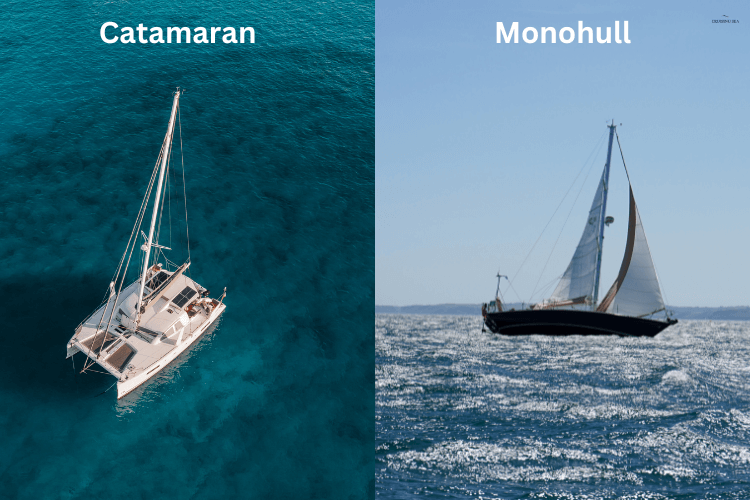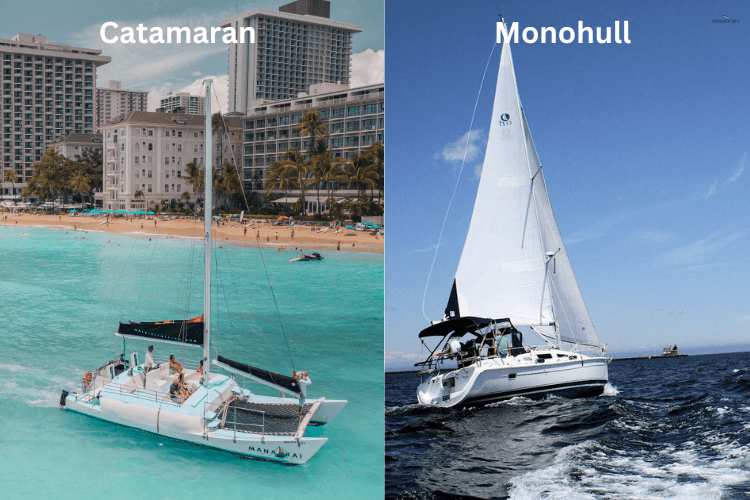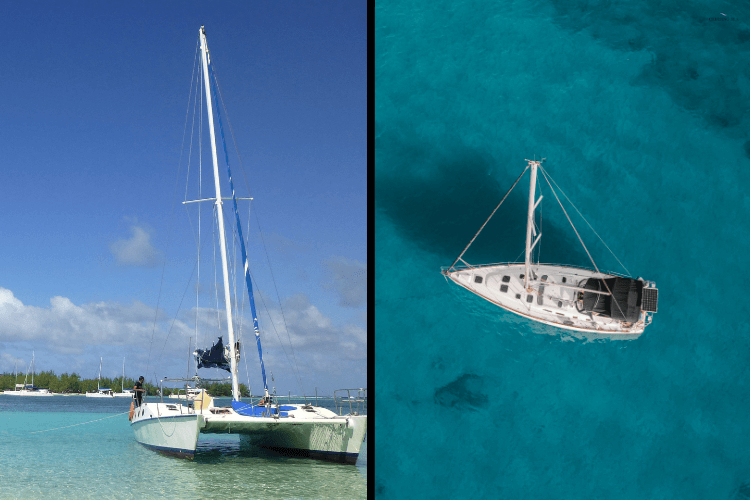When it comes to discussing the speed of boats, one classic debate arises: Are catamarans faster than monohulls? The answer to this question is more complex than it may seem, as numerous factors can influence the performance of these vessels.
In this article, I’ll dive into the intricacies of catamarans and monohulls, comparing their respective speeds and the factors that impact them, ultimately helping you determine which type of boat best suits your needs.
Key Takeaways
- Catamarans and monohulls have distinct speed capabilities due to their structural differences.
- Numerous factors influence the performance of these vessels, including design, sailing conditions, and crew experience.
- Real-world scenarios bring additional variables that can impact the overall speed comparison between catamarans and monohulls.

Overview of Catamarans and Monohulls
Here is a brief overview of catamarans and monohulls to help you understand their differences and characteristics.
Brief on Catamarans
Catamarans are boats with two parallel hulls of equal size. They are known for their stability, speed, and spacious interiors.
Due to their design, catamarans have a larger surface area on the water, allowing them to glide through waves more easily and with less drag.
This design feature contributes to their overall speed advantage over monohulls. Additionally, catamarans are lighter and have more efficient sails, which increase their sailing capabilities.
Brief on Monohulls
Monohulls, on the other hand, are boats with a single hull. They are known for their strength, affordability, and classic sailing experience. Monohulls offer a more traditional sailing experience, relying on a lead keel to provide stability and weight balance.
While they may not be as fast as catamarans in a straight line, monohulls can still be quite agile in various sea conditions. Monohulls also provide larger living spaces below the deck as their hull width is larger than a single hull on a catamaran.
Keep in mind that both catamarans and monohulls have their pros and cons, depending on your needs and preferences. It’s essential to consider factors like speed, stability, interior space, and budget when choosing between these two types of boats.
Speed Comparison

Catamaran
| Type of Monohull | Maximum Speed (knots) | Average Speed (knots) |
| Cruising monohulls | N/A | 6-8 |
| Racing monohulls | Over 40 | N/A |
| Vestas Sailrocket 2 (fastest on record) | 65.45 | N/A |
Monohull
| Type of Catamaran | Maximum Speed (knots) | Average Speed (knots) |
| Sailing cruising catamarans | 35 | 9-15 |
| Power cruising catamarans | 70 | 20 – 25 |
| Race catamarans | 40 | Over 30 |
When comparing the speed of catamarans and monohulls, there are several factors to consider. In general, catamarans tend to be faster than monohulls in straight-line sailing due to their lighter weight and narrower hull forms, which result in less drag.
Catamarans can achieve speeds of 15 to 20 knots, sometimes being 50% faster than similarly equipped monohulls. This increased speed is attributed to their dual-hull design, which allows for less resistance and a decrease in heeling or tilting when sailing.
On the other hand, monohulls’ single-hull design may produce more drag, slowing them down in comparison to catamarans.
However, this doesn’t mean that monohulls are always slower than catamarans. Monohulls are known for their strength and ability to point higher upwind, while catamarans might struggle to do so or may produce more leeway (sideways movement) when trying to sail upwind.
This can make monohulls a better choice for certain sailing conditions, especially when speed and agility are not the only factors to consider.
In summary, catamarans generally have an advantage in straight-line speed and stability, making them faster than monohulls in most situations. However, monohulls may have an edge in specific sailing conditions due to their ability to point higher upwind.
So, ultimately, the choice between the two will come down to your individual sailing preferences and needs.
Factors Affecting Speed
There are several factors that affect the speed of catamarans and monohulls. So, let’s dive into weight and stability, waterline length, and hull design.
Weight and Stability
Catamarans are generally lighter than monohulls of the same size. This is because they don’t have a lead keel, which allows more of the driving force from the sails to be converted into speed.
In addition, their stability comes from the wide distance between their two hulls, making them less likely to heel over and more stable at high speeds.
On the other hand, monohulls rely on their keel for stability, which adds weight and can slow them down.
Waterline Length
Waterline length plays a crucial role in determining a boat’s speed potential. Longer waterline lengths lead to higher hull speeds because they allow for lower wave resistance.
Catamarans often have longer waterline lengths compared to monohulls of the same size, which contributes to their higher top speeds.
However, it’s important to remember that factors like sail area and hull design can also affect a boat’s speed performance.
Hull Design
Hull design can greatly influence a boat’s speed and handling characteristics. Catamarans typically have narrower hull forms with less drag than wide hulls and deep keels found on monohulls.
This sleek design allows them to glide through the water with less resistance, increasing their overall speed potential. Furthermore, catamarans can maintain high speeds in various wind conditions thanks to their ability to sail closer to the wind.
In summary, catamarans generally have a speed advantage over monohulls due to their lighter weight, longer waterline lengths, and more efficient hull designs.
However, it’s important to consider other factors like sail area, handling, and specific conditions when comparing the overall performance of these two types of boats.
Real World Scenarios
Now, let’s dive into real-world scenarios to explore the performance of catamarans and monohulls in different sailing situations.
Ocean Passages
When embarking on ocean passages, speed is a significant factor for many sailors. Catamarans tend to be faster than monohulls of the same length and displacement, mainly due to their lighter weight and reduced drag in the water.
Catamarans often have higher straight-line sailing speeds than similar-sized or even longer monohulls.
However, monohulls should not be discounted when making ocean crossings. While they may not have the raw speed that catamarans boast, monohulls are built to be strong and capable of handling a variety of sea conditions.
Their lower center of gravity provides a smoother, more comfortable ride during long passages or rough seas.
Racing
In the world of competitive sailing, catamarans and monohulls face off in different classes of races. The inherent design differences between the two types of vessels make them suited for specific racing styles and conditions.
Catamarans, with their faster hull speed and better maneuverability, seem to have an edge in races held in lighter wind conditions and flat water. In these scenarios, a catamaran can take full advantage of its ability to quickly accelerate and maintain high speeds. However, the trade-off for this speed is that catamarans can be more challenging to control in strong wind conditions.
On the other hand, monohull sailboats excel in races where beating into the wind and tacking are essential. The traditional monohull design offers more stability and balance, making them a more reliable choice in heavier wind and sea conditions. Monohulls might not have the same top-speed potential as catamarans, but with the right crew and conditions, they can still be competitive in a race.
Keep in mind that boat design, crew skill, and weather conditions all play a crucial role in determining the performance of both catamarans and monohulls. The choice of a faster boat ultimately depends on your personal preferences and the specific sailing conditions you are likely to encounter.
Frequently Asked Questions
Q: How do catamaran and monohull speeds compare?
A: Catamarans are generally faster than monohulls of the same length and displacement. However, this is not always the case, as some older cruising catamarans may not go faster than 8 knots, while modern monohulls can exceed 10 knots. It is important to remember that there are various factors influencing the speed of both types of boats, including design, sailing conditions, and overall performance.
Q: What are the performance differences between catamarans and monohulls?
A: While catamarans are known for their straight-line speed, single-hull boats tend to sail closer to the wind. This can enable monohulls to reach destinations faster when upwind sailing is required. Additionally, monohulls usually have better responsiveness and sailing feel, providing immediate feedback from wind pressure and trim adjustments. Conversely, catamarans offer more stability and space, allowing for a smoother, more comfortable ride.
Q: How does the design of a catamaran affect its speed?
A: The design of a catamaran significantly contributes to its speed. With two hulls side-by-side, catamarans experience less resistance in the water, which translates to faster speeds. Additionally, their wide beam provides greater stability, allowing for larger sails and more power generation. Finally, the reduced risk of capsizing means that catamarans can often sail at higher speeds without compromising safety.
Q: What factors make catamarans faster or slower than monohulls?
A: Several factors can make catamarans faster or slower than monohulls. As mentioned earlier, the design of the boat plays a significant role in determining speed. Furthermore, the weight and loading of the boat, along with sail area and wind conditions, can impact the speed of both catamarans and monohulls. In some cases, such as sailing downwind or in choppy seas, monohulls may have a speed advantage.
Q: How do sailing conditions influence catamaran and monohull speeds?
A: Sailing conditions significantly influence the speeds of catamarans and monohulls. Catamarans perform well in flat conditions with a consistent wind, allowing them to maintain a high average speed. On the other hand, monohulls achieve better speeds in rougher seas, as their single-hull design enables them to cut through waves more effectively. The direction of the wind also affects the boats’ performance, with monohulls being more efficient when sailing upwind.
Q: Do catamarans have advantages over monohulls in terms of speed?
A: Yes, catamarans possess certain advantages over monohulls in terms of speed. Their design allows for a larger sail area, generating more power and speed. Catamarans also experience less resistance in the water due to their twin-hull design, which contributes to faster speeds in favorable conditions. However, it is essential to take into consideration that each boat type has its pros and cons, and factors such as sailing conditions and intended use will significantly impact the overall performance.
Final Words
In summary, catamarans are generally faster than monohulls of comparable size. As mentioned, this is due to their lighter weight and the shape of their hulls, which have less drag. Speed is an essential factor when choosing a vessel, but it’s crucial to balance it with other considerations such as stability, safety, and comfort.
Want More Tips?
Subscribe to Cruising Sea newsletter to receive every two weeks the latest posts straight to your inbox!

Daniella has been passionate about travel, the sea, and nature for many years. As a child, she frequently traveled throughout the Mediterranean and continued with her journeys throughout her adult life.
Her experiences have created the desire within her to share her love for traveling with other passionate and adventurers who want to discover beautiful horizons and new cultures.


As an avid fan of The Americas Cup for over thirty years, I found this article provides an excellent overview of the catamarans vs. monohulls debate, offering a comprehensive look at the factors affecting their speed and performance. It’s clear that there’s no one-size-fits-all answer, and the choice depends on various factors.
I appreciate the detailed comparison of speed between the two types of boats. It’s fascinating to see how catamarans can be significantly faster in straight-line sailing due to their design, but monohulls excel in upwind conditions. It’s a valuable insight for those considering which type of boat to invest in.
The frequently asked questions section is a great addition, as it addresses common queries readers may have. Overall, this article is a valuable resource for anyone looking to make an informed decision about their boat choice. Thank you for shedding light on this intriguing debate!
Hi there,
I’m glad you enjoyed the article on the Catamarans vs. Monohulls debate! It’s fascinating how the design influences their speed and performance in various conditions. Making an informed decision about choosing a boat is essential, and I’m pleased the article provided valuable insights. If you have more questions, feel free to ask. I’ll be more than happy to answer:)
Thank you for the comment and I wish you a lovely day.
Quick Question, this may be unrelated but what is the fastest type of boat to get? I was considering buying a boat, but not sure which type to go with. I like motorcycles and fast cars so I want something that is going to give me some adrenaline. But overall this is some really helpful information for me.
Hey there,
If you’re after an exciting, adrenaline-fueled boating experience, you’ve got some great options! Speedboats, jet boats, performance boats, hydroplanes, and Formula 1 powerboats all offer thrilling rides on the water. Just make sure to pick one that matches your skills, and don’t forget to prioritize safety!
I hope it helped, and if you have more questions, don’t hesitate to ask. I am always happy to assist.
Thank you for the comment, and I wish you a lovely day!